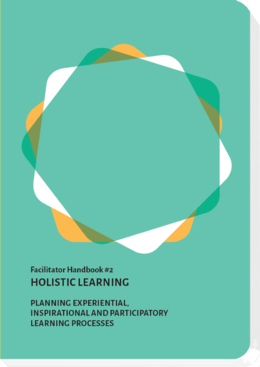As John Erpenbeck is putting it: “Action necessarily presupposes emotion.” [1] Creativity requires emotion. The wish to change or put new things on the agenda is not necessarily intellectual, but an expression of intrinsic, emotional motivation. Creative processes include emotions in all kinds of ways: positive (e.g. visions, embracing something new) or negative (e.g. protest or disagreement).
Contents
Aspects of Emotional Learning
- Feeling connected to others
- Playfulness
- Experiencing yourself in a group
- Experiencing positive and negative emotions
- Feeling capable and strong
Facilitation can make use of this emotional treasure by helping to bring it to the surface and make emotion accessible for learners to reflect on. As we put it in the second handbook for facilitators: “holistic learning seeks to increase our consciousness of our behaviors and skills. This helps individuals see how self-development takes place.“[2]
People need learning processes where they feel safe. In this context, safety means being able to express non-conforming or unfiltered ideas without negative consequences. They need a space where they are able to express their emotions in their own individual way. Learners need to see the gain they make from making their emotions accessible to themselves and others (for example better inspiration or support, or relief, or relaxation).
Manipulation
A non-facilitative way of emotional learning is manipulation - allowing people to invove their emotions not helping them to make use of them in a voluntary, transparent, self-responsible or independent way. In opposite - often manipulation is aiming to build dependence and to depower individuals. An attitude of practicized critical thinking is a balancing instrument for limiting overwhelming pedagogy. For preventing conscious and unconscious manipulation facilitators need to take as well active preventive measures like establishing and enforcing rules, reflecting their roles and supporting and sheltering people in emotional disbalance.
Facilitating Emotional Learning
- Start with reflecting the needs of learners including the emotional needs.
- Establishing good working conditions helps to build trust in a group, one main condition for such safe spaces.
- Motivation is a required emotion for competency development. And in the opposite - if motivation is fading away, sustainable and voluntary learning will become less feasable.
- Basic rules help learners to be sure, not to take part in manipulative learning processes (Stop rule, disagreement rule, discretion rule).
- Reflection of facilitators on their roles and how they make use from their authority.
References
- ↑ John Erpenbeck: Stichwort Kompetenzen in: DIE Zeitschrift für Erwachsenenbildung; III 2014
- ↑ Nils-Eyk Zimmermann, Elke Heublein (Ed.): Holistic Learning - Planning experiential, inspirational and partcipatory learning processes; Facilitator handbook #2; Competendo - Tools for Facilitators





